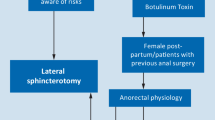Abstract
Purpose
The constant presence of a narrow subcutaneous tract extending caudad to chronic fissures-in-ano is reported. The efficacy of surgically unroofing this tract (subcutaneous fissurotomy) without sphincterotomy was evaluated.
Methods
By using a narrow-gauge, hooked probe, a constant, midline subcutaneous tract was identified extending from the caudad aspect of chronic anal fissures. These tracts are present within the sentinel tag, when present, and extend up to 1 cm caudad to the fissure in the subcutaneous plane. A proximal connection with the dentate line in the submucous plane also was identified. Surgically unroofing the tract (subcutaneous fissurotomy) resulted in significant widening of the distal anal canal, rendering internal sphincterotomy unnecessary. A 32-month prospective evaluation of this new technique was performed. Inclusion criteria included patients with chronic anal fissures that had failed conservative therapy, including topical agents. In each case, the tract was identified and surgically laid open along its entire length. No internal sphincterotomy was performed in any patient. Postoperatively, patients were instructed to apply topical 10 percent metronidazole t.i.d. The need for repeat surgery and/or subsequent internal sphincterotomy was recorded.
Results
A total of 109 patients were enrolled during the study period. Median follow-up was 12 months. During the study period, two patients (1.8 percent) required repeat surgery for persistent symptoms at 3 and 12 months postoperatively. No change in continence was reported in any patient.
Conclusions
Laying open the subcutaneous tract has a very high success rate and a low incidence of repeat surgery. This finding introduces a new debate relating to the etiology of fissure-in-ano and makes routine internal sphincterotomy unnecessary.





Similar content being viewed by others
References
Orsay C, Rakinic J, Perry WB, et al.Standards Practice Task Force, The American Society of Colon and Rectal Surgeons. Practice parameters for the management of anal fissures (revised). Dis Colon Rectum 2004;47:2003–7.
Nelson RL. Meta-analysis of operative techniques for fissure-in-ano. Dis Colon Rectum 1999;42:1424–31.
Romono G, Rotondano G, Santangelo M, et al. A critical appraisal of the pathogenesis and morbidity of surgical treatment of chronic anal fissure. J Am Coll Surg 1994;178:600–4.
Abcarian H. Surgical correction of chronic anal fissure: results of lateral internal sphincterotomy vs. fissurectomy—midline sphincterotomy. Dis Colon Rectum 1980;23:31–6.
Garcia-Aguilar J, Belmonte C, Wong WD, et al. Open vs closed sphincterotomy for chronic anal fissure: long-term results. Dis Colon Rectum 1996;39:440–3.
Khubchandani IT, Reed JF. Sequelae of internal sphincterotomy for chronic fissure-in-ano. Br J Surg 1989;76:431–4.
Casillas S, Hull TL, Zutshi M, et al. Incontinence after a lateral internal sphincterotomy: are we underestimating it? Dis Colon Rectum 2005;48:1193–9.
Rotholtz NA, Bun M, Mauri MV, et al. Long-term assessment of fecal incontinence after lateral internal sphincterotomy. Tech Coloproctol 2005;9:115–8.
Wiley M, Day P, Rieger N, et al. Open vs. closed lateral sphincterotomy for idiopathic fissure-in-ano: a prospective, randomized, controlled trial. Dis Colon Rectum 2004;47:847–52.
Hyman N. Incontinence after lateral internal sphincterotomy: a prospective study and quality of life assessment. Dis Colon Rectum 2004;47:35–8.
Pernikoff BJ, Eisenstat TE, Rubin RJ, et al. Reappraisal of partial lateral internal sphincterotomy. Dis Colon Rectum 1994;37:1291–5.
Nyam DC, Pemberton JH. Long-term results of lateral internal sphincterotomy for chronic anal fissure with particular reference to incidence of fecal incontinence. Dis Colon Rectum 1999;42:1306–10.
Goligher J. Surgery of the anus, rectum and colon. Anal fissure. 5th ed. London: Balliere Tindall, 150–166:1984.
Ram E, Alper D, Gideon Y, et al. Internal anal sphincter function following lateral internal sphincterotomy for anal fissure. A long-term manometric study. Ann Surg 2005;242:208–11.
Thornton MJ, Kennedy ML, King DW. Manometric effect of topical glyceryl trinitrate and its impact on chronic anal fissure healing. Dis Colon Rectum 2005;48:1207–12.
Antropoli C, Perrotti P, Rubino M, et al. Nifedipine for local use in conservative treatment of anal fissures: preliminary results of a multicenter study. Dis Colon Rectum 1999;42:1011–5.
Kocher HM, Steward M, Leather AJ, Cullen PT. Randomized clinical trial assessing the side-effects of glycerol trinitrate and diltiazem hydrocholoride in the treatment of chronic anal fissure. Br J Surg 2002;89:413–7.
Perrotti P, Bove A, Antropoli C, et al. Topical nifedipine with lidocaine ointment vs. active control for treatment of chronic anal fissure: results of a prospective, randomized, double-blind study. Dis Colon Rectum 2002;45:1468–75.
Jonas M, Neal KR, Abercrombie JF, Scholefied JH. A randomized trial of oral vs. topical diltiazem for chronic anal fissures. Dis Colon Rectum 2001;44:1074–8.
Minguez M, Herreros B, Espi A, et al. Long-term followup (42 months) of chronic anal fissure after healing with botulinum toxin. Gastroenterology 2002;123:112–117.
Schouten WR, Briel JW, Auwerda JJ. Relationship between anal pressure and anodermal blood flow. The vascular pathogenesis of anal fissures. Dis Colon Rectum 1994;37:664–9.
Schouten WR, Briel JW, Auwerda JJ, et al. Ischaemic nature of anal fissure. Br J Surg 1996;81:63–65.
Gupta PJ, Kalaskar S. Removal of hypertrophied anal papillae and fibrous anal polyps increases patient satisfaction after anal fissure surgery. Tech Coloproctol 2003;7:155–8.
Ravikumar TS, Sridahr S, Rao RN. Subcutaneous lateral internal sphincterotomy for chronic fissure-in-ano. Dis Colon Rectum 1982;25:798–801.
Carapeti EA, Kamm MA, McDonald PJ, Phillips RK. Double-blind randomized controlled trail the effect of metronidazole on pain after day case hemorrhoidectomy. Lancet 1998;351:169–72.
Nicholson TJ, Armstrong DN. Topical metronidazole (10 percent) decreases posthemorrhoidectomy pain and improves healing. Dis Colon Rectum 2004;47:711–6.
Stringer E, Nicholson TJ, Armstrong DN. Efficacy of topical metronidazole (10 percent) in the treatment of anorectal Crohn’s disease. Dis Colon Rectum 2005;48:970–.
Author information
Authors and Affiliations
Corresponding author
Additional information
Dr. Armstrong has a patent licensing agreement with SLA Pharma AG for topical 10 percent metronidazole.
About this article
Cite this article
Pelta, A.E., Davis, K.G. & Armstrong, D.N. Subcutaneous Fissurotomy: A Novel Procedure for Chronic Fissure-in-ano. A Review of 109 Cases. Dis Colon Rectum 50, 1662–1667 (2007). https://doi.org/10.1007/s10350-007-9022-5
Published:
Issue Date:
DOI: https://doi.org/10.1007/s10350-007-9022-5




